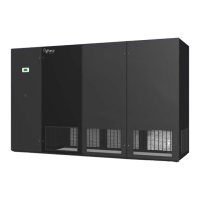27
WARNING: Before starting a compressor, the crankcase heater should be energized
for a minimum of 12 hours to reduce the possibility of liquid slugging on start-up. Failure
to energize the crankcase heater could result in compressor damage. If the system is
charged from a vacuum, the pre-heating of the compressor is not necessary.
Charging requires the unit the unit operation. A quick and easy way to run the compressor and
blowers is to use the manual switches on the unit’s Manual Override Switch board located next to the
microprocessor control module. Switching the Fan and Cool 1 or 2 manual switches to the ON position
will disable the automatic control of these components but leave the safety switches functional.
After the system has been satisfactorily evacuated the lines can be charged with refrigerant. Connect
the pressure gauge manifold set to the high and low ports near the compressor. Connect the charging
line to the refrigerant tank and set it for liquid feed. Open the refrigerant tank valve and purge the line
at the manifold, then open the high side valve on the manifold only. Add 2.5 pounds (.70 pounds per
kW) of refrigerant per nominal ton plus the weight of the refrigerant for the liquid line only. At this point
the system will have 75 to 80% of the total refrigerant charge. Start the fans and then the compressor
checking the operating pressures and temperatures.
Start operating the system and slowly meter in refrigerant checking the sub-cooling as refrigerant is
being added. Charge the system to 8 to 10°F (4.4 to 5.6 °C) of sub-cooling – DO NOT OVER CHARGE
THE SYSTEM.
The system should be allowed to stabilize for 15 to 20 minutes before meaningful measurements can
be taken. After the system is allowed to stabilize, verication of a few key measurements should be
noted. Measure the superheat at the compressor suction line at least 6 inches (152 mm) away from
the compressor. A properly charged system operating at typical parameters will have the following
pressures:
Refrigerant
Discharge Head
Pressure
1
Sub-Cooling
2
(depending on ambient
conditions)
Suction
Pressure
3
Superheat
4
R-410A
340 to 415 PSIG
(2.34 to 2.86 MPa)
8 to 10°F
(4.4 to 5.6 °C)
104 PSIG
(0.72 MPa)
or greater
8 to 15°F
(4.4 to 8.3°C)
R-407C
245 to 285 PSIG
(1.69 to 1.97 MPa)
8 to 10°F
(4.4 to 5.6 °C)
52 PSIG
(0.36 MPa)
or greater
8 to 15°F
(4.4 to 8.3°C)
Note: Bubbles in the sight glass are not unusual at this point and there generally
will be ashing and/or bubbles in the sight glass when the system is properly
charged. A system with fan speed control charged to a clear sight glass is often
overcharged.
1 Discharge pressure (also called high side pressure or head pressure) is the pressure generated on the output
side of a gas compressor in a refrigeration or air conditioning system. The discharge pressure is aected by several
factors: size and speed of the condenser fan, condition and cleanliness of the condenser coil, and the size of the
discharge line.
2 Subcooling refers to a liquid existing at a temperature below its normal saturation temperature. Subcooling is
normally used so that when the cycling refrigerant reaches the thermostatic expansion valve, its totality is in its liquid form,
thus, allowing the valve to work properly.
3 Suction pressure’ (also called the low-side pressure) is the intake pressure generated by the system compressor
while operating. The suction pressure, along with the suction temperature and the wet bulb temperature of the discharge
air are used to determine the correct refrigerant charge in a system.
4 After all of the refrigerant has boiled to a vapor, any additional temperature increase above the boiling point is
called superheat

